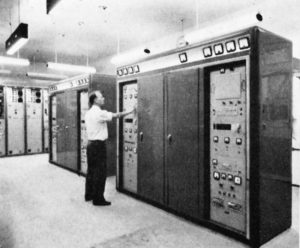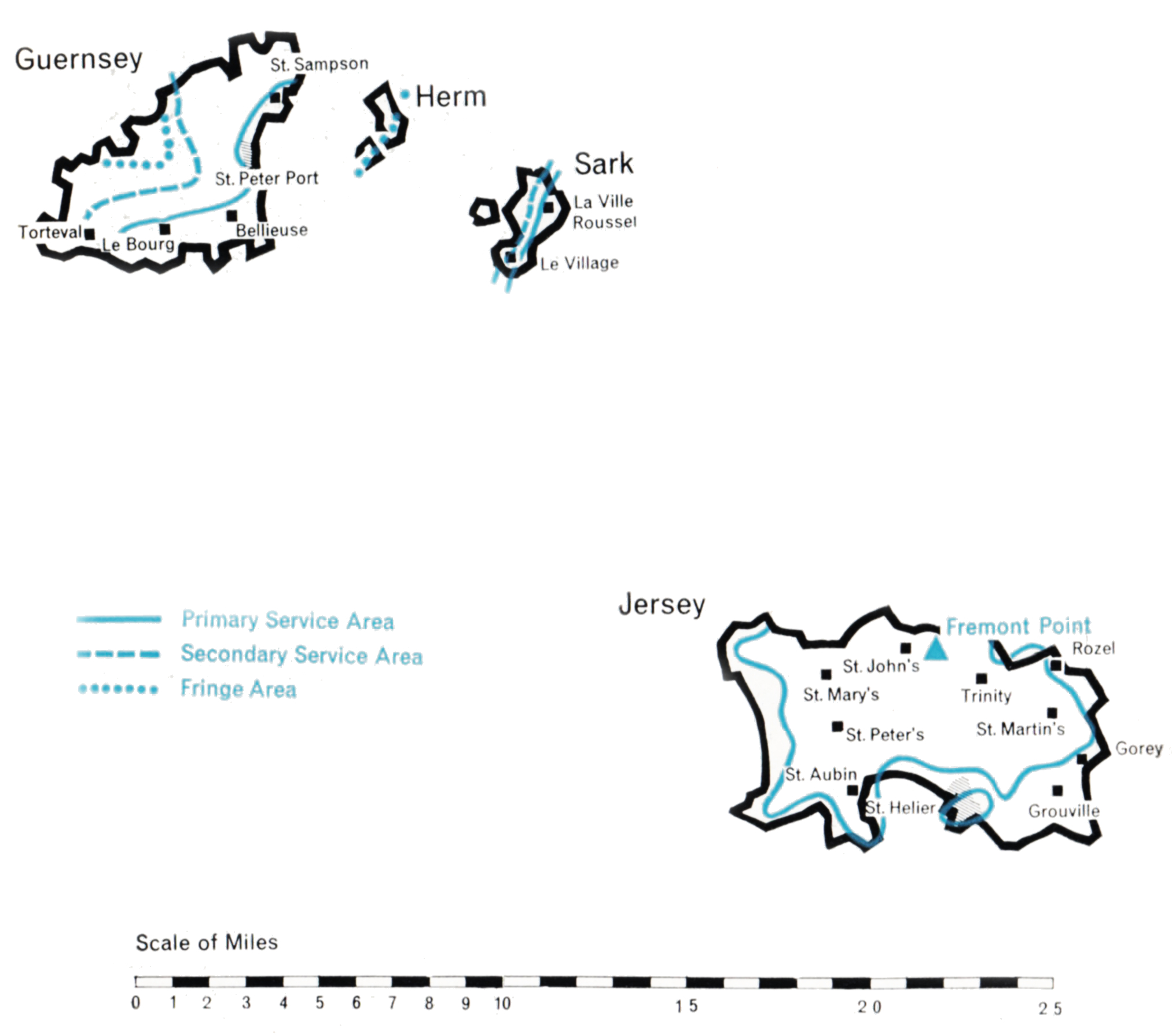- Population within measured contours: Primary 0.0513 mn, Secondary 0.0449 mn, Fringe 0.0038 mn. Total 0.10 mn.
- Channel: Band III Channel 9 (horizontally polarised)
- Vision Carrier Frequency: Actual 194.75 Mc/s
- Sound Carrier Frequency: Actual 191.25 Mc/s
- Effective Radiated Power: Vision 10 kw maximum. Sound 2.5 kw maximum.
- Power of Transmitters: Vision (peak white) 2 x 0.5 kW. Sound (carrier) 2 x 1.25 kW
- Heights above sea level: Site 330 ft above sea level. Mean aerial 760 ft. above sea level
- Location: 2° 7′ 52″ W, 49° 15′ 8″ N.
Fremont Point (Channel 9)
Company: Channel Television
The Channel Islands lie in a dispersed group well out in the English Channel and close to the French coast, off the Cherbourg Peninsula. The population is concentrated mainly in the two largest islands, Jersey and Guernsey, about 6o,ooo in the former and 4o,ooo in the latter. The largest town is St. Helier on Jersey. The distance between Jersey and the Authority’s nearest mainland transmitting station, Stockland Hill, is about 120 miles, virtually all across sea. The island nearest to Stockland Hill is Alderney, the path length in this case being about 8o miles.
Studies showed that the only Band III channel which could be used to cover the islands without causing harmful interference in the service areas of several French stations was Channel 9, horizontally polarised, and even with this channel it would be necessary to restrict the power radiated towards the French coast to about 1 kW. Accordingly it was necessary to site the transmitting station on the north coast of Jersey, where 1 kW was just enough to serve that island, and to beam a higher power, 10 kW, across the sea to Guernsey which lies 25 miles distant in the direction of the English mainland.
 The supply of mainland programmes to the Jersey station for rebroadcasting in the islands presented unusual problems because, of necessity, both Stockland Hill and Fremont Point had to use Channel 9. The solution was to install on the small island of Alderney an “off the air” receiving station using diversity reception techniques, to pick up the Channel 9, vertically polarised, transmission from Stockland Hill 8o miles away and pass it over a multichannel microwave link to Fremont Point. The overseas path length of the microwave circuit is about 4o miles. To ensure that the Stockland Hill signal could be received in Alderney without interference from Fremont Point, the power radiated by Fremont Point towards Alderney on the same channel had to be restricted to the low value of 200 watts. This means that the people of Alderney are unable to receive the local programmes transmitted by Fremont Point, but fortunately many of them are able, with good aerials and receivers, to view directly if somewhat inconsistently the transmissions from Chillerton Down on Channel 11.
The supply of mainland programmes to the Jersey station for rebroadcasting in the islands presented unusual problems because, of necessity, both Stockland Hill and Fremont Point had to use Channel 9. The solution was to install on the small island of Alderney an “off the air” receiving station using diversity reception techniques, to pick up the Channel 9, vertically polarised, transmission from Stockland Hill 8o miles away and pass it over a multichannel microwave link to Fremont Point. The overseas path length of the microwave circuit is about 4o miles. To ensure that the Stockland Hill signal could be received in Alderney without interference from Fremont Point, the power radiated by Fremont Point towards Alderney on the same channel had to be restricted to the low value of 200 watts. This means that the people of Alderney are unable to receive the local programmes transmitted by Fremont Point, but fortunately many of them are able, with good aerials and receivers, to view directly if somewhat inconsistently the transmissions from Chillerton Down on Channel 11.
There are many complications in this apparently simple vision link scheme. The distances are such that the changing propagation conditions over the sea paths involved will cause wide fluctuations in the strength of the signals received in Alderney from Stockland Hill, and for a small proportion of the time these signals may be unusable for rebroadcasting from Fremont Point. The programme service began on 1st September 1962.

